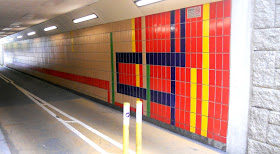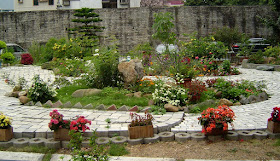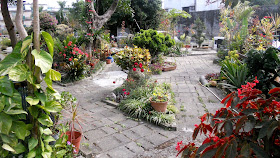Although I’ve cycled through Taipo, which is 5–6km south of Fanling, scores of times over the past 10 years, the route I used to follow did not pass through any subways, and the route I now follow passes through only one, where the inattentiveness of pedestrians crossing the cycle track makes it unwise to pay any attention to the walls of that subway. However, as a result of the excursion described in Surprise View, I began to notice how colourful were the subways that I had to pass through there:
Believe it or not, the transition from the light blue background colour to red takes place deep underground, between the entry in the second photo and the exit in the third.
After this, I began to pay more attention to other subways, including those that I passed when cycling alongside the Lam Tsuen River on my way south. They weren’t as obvious as the ones pictured above, because in these cases, the front elevation was masonry and therefore not visually striking. And these were merely underpasses rather than subways, so there weren’t any long descending approaches requiring decoration, which I would have been bound to notice.
However, when I did take a closer look, I was delighted to discover some spectacularly colourful designs:
The most interesting aspect of this design is that it is repeated in every underpass that I’ve checked out, but the colour combinations differ. I did think at one point that you might be able to work out which underpass you were in depending on the colours, but I eventually discovered that some combinations are repeated, and to date I’ve found only four different ones:
Continuing south from Taipo, there are two cycle-only subways in the vicinity of the Hong Kong Science Park, on the northern edge of Shatin. In both cases, the design is meant to represent waves, although that may not be obvious from these photographs:
You may need to ride through the full length of these subways to be convinced that my interpretation is correct, but I can assure you that there are gradual changes from one wave to the next, which overall give an impression of breaking.
Immediately upon emerging from the second subway, it is possible to turn off the main cycle track through a pedestrian subway, at the end of which a detached cycle track leads to University station. Before coming to an end behind the Hyatt Hotel, this track passes under the bus/minibus station in front of the railway station:
Whenever I’m cycling around here, as soon as it’s possible to cross the Shing Mun River, I do so. I then follow a circuit around the cycle tracks of Ma On Shan, the newest of the new towns in the New Territories and the only one built in the middle of nowhere. There aren’t many subways or underpasses here, and this is the only one of interest:
The circuit around Ma On Shan comes back to the same place, and when I’m down this way, I usually then continue south down the east bank of the river, eventually coming to a long subway between Shek Mun and City One stations on the Ma On Shan line:
The slightly unnatural colour of the first photograph is the result of having to use flash, but the second photo shows the insipidity of the colour scheme here. If only they’d used the kind of vibrant colours that characterize Taipo’s subways!
My regular route passes through several other subways and cycle-track interchanges before reaching the location of the next photograph, but their designs are uniformly uninteresting. However, the next subway is, as far as I can tell, unique:
It reminds me of the cloister of a monastery—and the design is repeated on the walls of the entry/exit ramps.
Like the Ma On Shan picture (above), this subway wall features a tree motif, although in neither case can they be compared with the bold tree motif in Sheung Shui that I used in my previous post:
My final example is not wildly exciting either. This is one of three consecutive bridges on a cycle track leading to Fo Tan. The red-and-white chequerboard design is repeated in a nearby subway.
Although I don’t give up hope easily, I think that I’ve covered everything of interest in the subways of Fanling, Taipo and Shatin. However, if I do find anything worthwhile in the future, you will find a report here.



























































